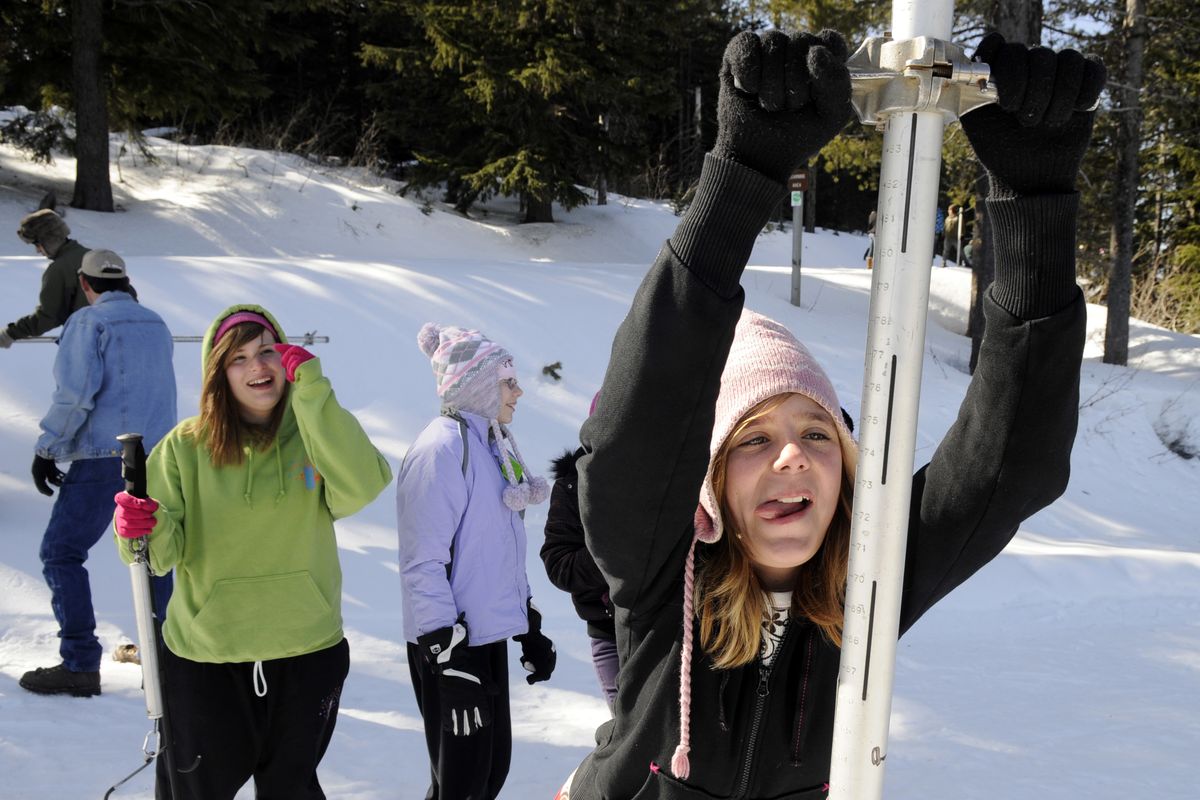Low snowpack levels have officials making drought plans

As cross-country skiers whizzed along crusty trails of hardened snow at Mt. Spokane Ski and Snowboard Park last week, Scott Pattee taught a boisterous group of grade-schoolers how to measure the snowpack’s water content.
Snowpack is critical to Northwest lifestyles, Pattee told the West Valley City School students. It affects everything: hydropower generation, electric bills, endangered salmon survival, irrigation, drinking water supplies and recreation.
“Do you like to go boating or water ski? The snowpack affects lake levels in Lake Coeur d’Alene,” said Pattee, a water supply specialist who works for the federal Natural Resources Conservation Service.
In the Pacific Northwest, 80 percent of the region’s surface water comes from the mountain snowpack deposited by winter storms. So far, the year is shaping up on a parched note.
The snowpack is 51 percent of average in the Spokane/Coeur d’Alene basins, with river flows forecast at 41 percent of normal through September. Other basins are also hurting. Near Seattle, the Cedar River basin’s snowpack is 51 percent of the 30-year average, tying the Spokane basin for the state’s lowest snowpack average. At elevations below 4,000 feet, most of the region is already bare and dry.
“We’re experiencing the infamous El Niño,” Pattee said, referring to the weather pattern that typically brings mild, dry winters to the Northwest.
The Olympic Peninsula and several Okanogan County drainages are among the exceptions. Those areas benefited when January storms hovered over the coastal region, then skipped across the Cascades to dump higher-than-normal snowfall in one of the state’s driest areas, Pattee said.
After teaching the West Valley students how to size up the snowpack Thursday morning, Pattee spent the afternoon on a conference call with federal and state officials. Drought is already in the forecast.
Gov. Chris Gregoire asked for $4.2 million in the upcoming budget to replenish Washington’s drought relief fund. Money from the fund can be used to drill deeper wells and pay farmers not to grow and irrigate crops. That leaves more water in streams for fish and other aquatic creatures.
A formal drought declaration could come after April 1, which would allow Washington to tap federal dollars for drought relief.
Snowpacks typically reach their peak moisture content by early April, so the next few weeks will be telling.
“Pray for snow,” was Bruce Suzumoto’s terse advice. Suzumoto works for NOAA Fisheries, which is predicting strong chinook salmon returns to the Columbia River system this year. But the pulse of fish will coincide with lower flows, meaning less favorable spawning conditions in small tributary streams, he said. Low flows also affect juvenile salmon smolts’ trip to the ocean. Instead of getting swept down the Columbia on high flows, they could linger in the sluggish backwater behind dams, where they’re easy prey for birds.
In the Inland Northwest, lower-than-average snowpack will affect Avista Corp.’s power generation. The Spokane-based utility gets 49 percent of its electricity from dams on the Clark Fork and Spokane rivers.
Avista Utilities’ assessments of runoff into the Spokane and Clark Fork river drainages continue to deteriorate.
Two weeks ago, flows into the Spokane were estimated at 44 percent of normal, and into the Clark Fork at 67 percent of normal. The utility adjusted those figures down to 41 percent and 61 percent, respectively, last week.
A U.S. Department of Agriculture map puts the Spokane drainage among the worst in the region for projected stream flow.
“We could get a wet spring, a wet summer,” Avista spokesman Hugh Imhof said, but the utility no longer relies as heavily on hydropower as it did in the past.
Ten years ago, a combination of early runoff, a dysfunctional California energy market and predators such as Enron Corp. drove wholesale electricity prices to unprecedented levels. Avista and other Northwest utilities responded by adding more than 6,700 megawatts of new generating capacity, enough for six cities the size of Seattle.
Avista has built or purchased almost 600 megawatts of new natural gas generation. The company has also added co-generation capacity to its Kettle Falls biomass plant and continues to upgrade its dams.
“We don’t expect that we will be short of electricity at all,” Imhof said.
Water for recreation is another story. “We expect a good whitewater season on the Spokane River through May. Who knows beyond that?” said David Lawrence, owner of Pangaea River Rafting.
Pangaea also offers rafting trips on the Clark Fork River, which offers Class 3 rapids even during low flow years. And the company’s Spokane River floats continue all summer. The experience is just a little different when river flows drop, Lawrence said.
“You get less of the white-knuckle experience,” he said, but “it’s still a fun, frolicking adventure.”
Boaters on Lake Coeur d’Alene might also have to adjust their expectations. Avista uses the Post Falls Dam to control the lake level. The utility won’t have trouble filling the lake, but a hot, dry summer could affect water levels later in the season, Imhof said.
To protect native redband trout habitat and provide for aesthetic flows over Spokane Falls, Avista must release set amounts of water from Lake Coeur d’Alene. The releases guarantee certain minimum flows in the Spokane River, which are dictated by the utility’s federal hydropower license.
Fortunately for the Northwest, regional droughts rarely last more than a year or two, said Pattee, the water supply specialist. The last major drought occurred in 2005. Even with this year’s low snowpacks, “we’re still quite a bit better than we were then,” Pattee said.
That year, people could cross shallow parts of the Spokane River by jumping from boulder to boulder, Imhof said.